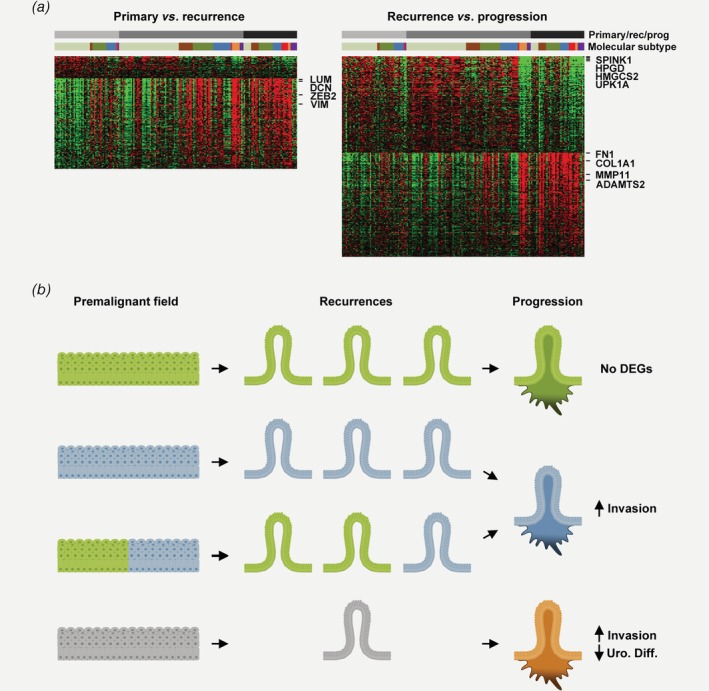Figure 6.

Differential gene expression between primary tumors, recurrences and progression tumors suggests stochastic or punctuated rather than gradual modes of progression. Heatmap in (a) (left) showing expression in the full data set of 135 genes differentially expressed between primary tumors and subsequent recurrences. Genes upregulated in recurrences formed a coherent signature and were mainly coding for ECM components (LUM, DCN) and markers of nonepithelial cells (ZEB2, VIM). Heatmap in (a) (right) showing expression in the full data set of 239 genes differentially expressed between the last NMI recurrences and subsequent progression tumors. Genes upregulated in progression tumors formed a coherent signature and were mainly coding for ECM components (FN1, COL1A1) and genes involved in ECM remodeling and invasion (MMP11, ADAMTS2). The top downregulated genes in progression tumors were members of a urothelial differentiation signature expressed in luminal‐like subtypes (SPINK1, HPGD, HMGCS2 and UPK1A). Ordering by molecular subtype, revealed such downregulation primarily in nonluminal‐like tumors and the same analysis, limited to patients with stable Urothelial‐like subtype (UroA, light green, UroB, brown or UroC, dark green) resulted in no significant DEGs. (b) Schematic model suggesting different modes of progression in bladder cancer: In the stable modality (first and second panels), patients recur and progress stably within the Uro subtype (green color) or the GU subtype (blue color), suggesting a common origin of all recurrences in a premalignant field that only produces tumors of one subtype. In the unstable modality (third and fourth panels), patients either develop both Uro or GU recurrences and progress with a GU subtype, or progress to a nonluminal‐like subtype (orange color, bottom). Patients that progress with a nonluminal‐like subtype had few prior recurrences that could be of any subtype (gray). The unstable modality of progression involves radical shifts in molecular subtype over the disease course suggesting an underlying premalignant field that is either heterogeneous or evolving to gives rise to various subtypes. [Color figure can be viewed at http://wileyonlinelibrary.com]
